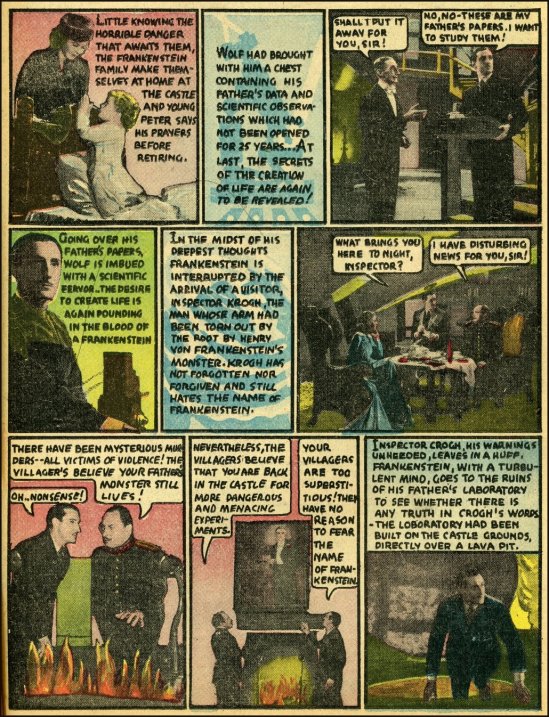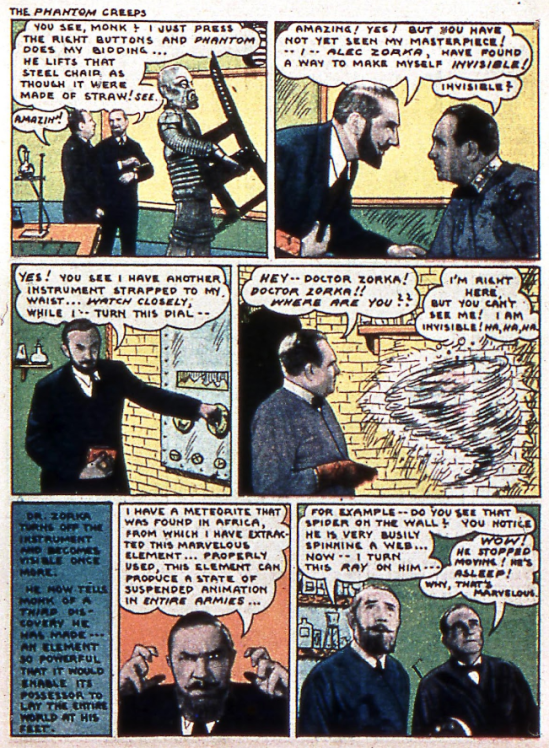Movie Comics No. 1, April 1939
Founded in 1938 by Max Gaines, inventor of the modern comic book format, All-American Publications introduced some of the most enduring superheroes during the Golden Age of comic books in the 1940s. Its roster included Flash, Atom, Green Lantern, Hawkman and Wonder Woman.
The company made its debut on the American comic book market in April 1939 with two titles, its flagship All-American Comics and Movie Comics. Although it ran for 102 issues until October 1948, All-American Comics was an unoriginal repackaging of newspaper comic strips with occasional original stories. Movie Comics, however, was a new idea.
Bearing the tagline “A Full Movie Show For 10¢,” Movie Comics utilised the fumetti technique of using photographs as the basis for its illustrations. Film stills and publicity shots were cut up and retouched to make composite images which were laid out on minimalist or crudely drawn backgrounds with added speech bubbles and captions. The images were inked in “natural colors,” a cover boast that was as unrealistic as the colours themselves and dropped after the third issue. The design, compositing and additional art was the work of Jack Adler, who eventual became Vice President of Production at DC Comics where he innovated several printing techniques which became standard practices in comic book production.

A look at Jack Pierce’s make up skills from Movie Comics No. 1
The cover of the first issue announced “complete” adaptations of the films Son of Frankenstein, Gunga Din, The Great Man Votes, Fisherman’s Wharf and the serial Scouts to the Rescue, plus “Shorts, News Reels and Comedies.” In addition to the eight-page adaptation of Son of Frankenstein, the issue also contained Movie-Make Up: From Man to Monster, a feature on how Jack Pierce transformed Boris Karloff into the creature and Bela Lugosi into Ygor.
This new comic book concept proved to be short-lived. Due to poor sales, the September – October issue was the sixth and final issue of Movie Comics. Perhaps in an effort to cut costs on the ailing comic book, the quality of the “artwork” had by this issue sunk to an unbelievably amateurish level. For Lugosi fans, however, it is another issue of great interest.
Movie Comics No. 6, September – October 1939
The cover story was an eight-page adaptation of his 12-part Universal serial The Phantom Creeps. The centre spread contained a Phantom Creeps contest with a $10 first prize, $5 second prize and ten additional $1 prize. To win, readers had to write a letter telling the first thing they would do if they had the Devisualizer, an invisibility device invented by Dr. Zorka, Lugosi’s character in the serial. The letters were judged on individuality and “neatness.” All entrants received a free “beautiful” Phantom button, now a collectible in itself.
The Phantom Creeps Contest from Movie Comics No. 6
Although Bela Lugosi received no financial reward for his appearance in the Movie Comics adaptations, they were evidence of the remarkable turnaround in his fortunes. After the so-called British ban on horror films led to Hollywood studios ceasing production of horror films, the severely typecast actor found himself all but unemployable in the film colony. Apart from one week’s work in the 1937 Republic serial S.O.S Coastguard, by 1938 he had not been offered film work for two years and was suffering dire financial problems. At the start of the year, he had been forced to apply to the Motion Picture Relief Fund for help with medical costs when his son, Bela George Lugosi, Jr., was born on January 5th, 1938. In August, he was forced to move into a rented house when the mortgage company foreclosed on his Outpost Drive mansion. In the same month, his saviour arrived in the unexpected form of Emil Umann, manager of the Regina cinema in Los Angeles. While trying to stave off bankruptcy, Umann began what was intended as a four-day run of a tripple-bill feature of Dracula, Frankenstein and Son of King Kong. The bill unexpectedly captured the public’s imagination, becoming an overnight sensation that was soon playing 21 hours a day to packed houses while police controlled the crowds queuing around the block. In response, Universal rushed Son of Frankenstein into production on October 17th, heralding the beginning of the second cycle of Hollywood horror films and, for now, the end of Lugosi’s financial woes. In addition to Son of Frankenstein and The Phantom Creeps, 1939 cinemagoers saw Lugosi in The Gorilla, Ninotchka, and the British Dark Eyes Of London.
Max Gaines sold his share in All-American Publications in 1944 and formed Entertaining Comics, more commonly known as EC Comics. His son William led the company to great success with titles such as Tales from the Crypt, The Vault of Horror, The Haunt of Fear, Weird Science, Weird Fantasy and Mad after Gaines was killed in a boating accident in 1947. After Gaines’ departure from All-American Publications, the company was merged with National Comics, the foundation of the modern-day DC comics.
Copies of Movie Comics are now very collectible, with issue one selling for up to $11,000. (Andi Brooks)
* * *
Movie Comics No. 1, April 1939
Son of Frankenstein
* * *
Movie Comics No. 6, September – October 1939
The Phantom Creeps
Related pages and articles
Related pages
Movie Action Magazine January 1936: The Invisible Ray Novelization
A collection of editions of Dracula and Bela Lugosi-related books




















These are beautiful. This is the type of commercial art that today’s graphic novel artists should be looking at for inspiration. The raw energy is exhilarating. In a way it reminds me of George Herriman’s Krazy Kat. A book of these would be worth publishing.
LikeLike
I agree Tom. It would be wonderful to see them reprinted.
LikeLike
Great stuff! Thank you!!
LikeLike
Thank you Peter. Glad that you enjoyed it.
LikeLike
WONDERFUL!
LikeLike